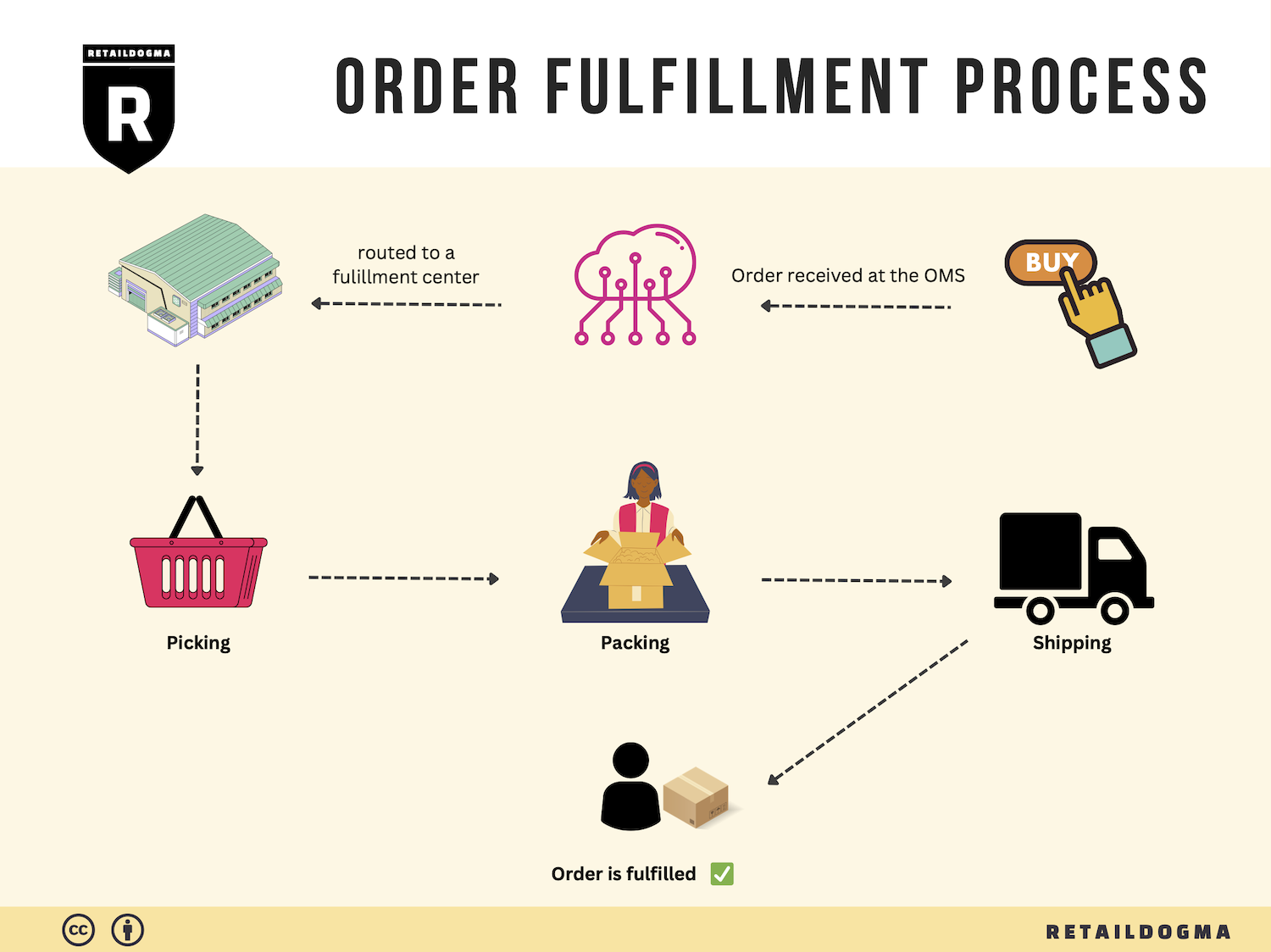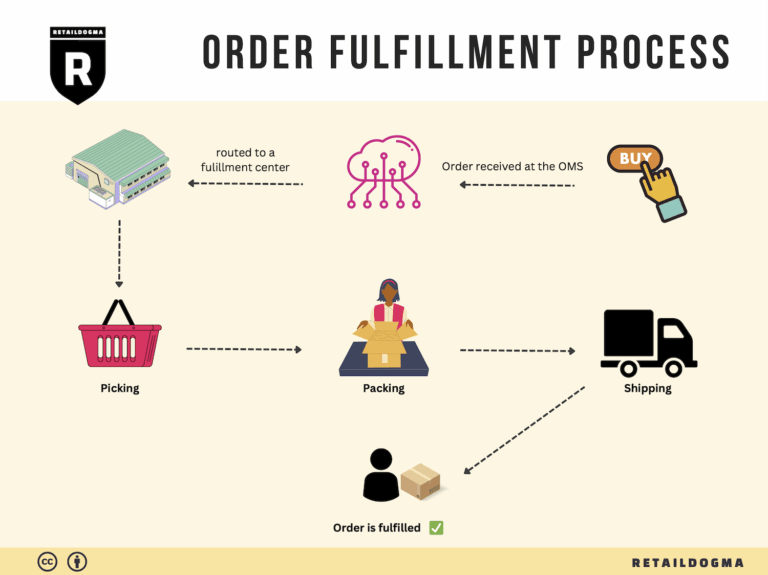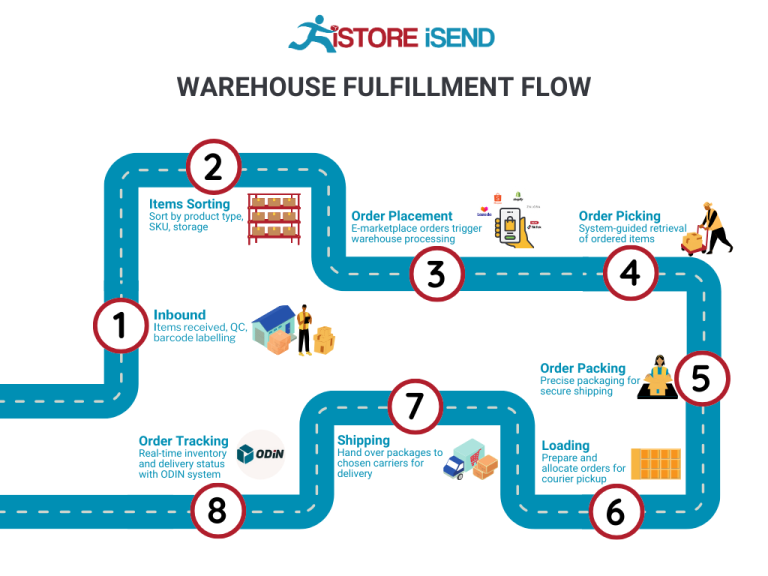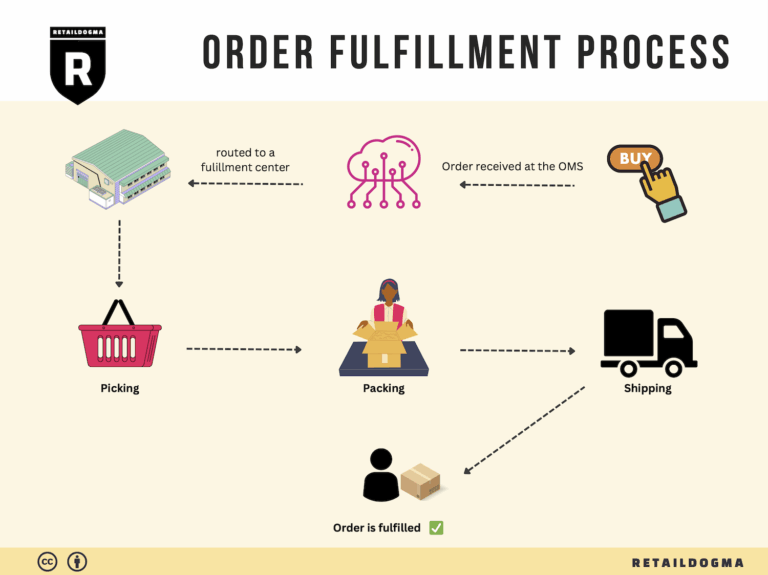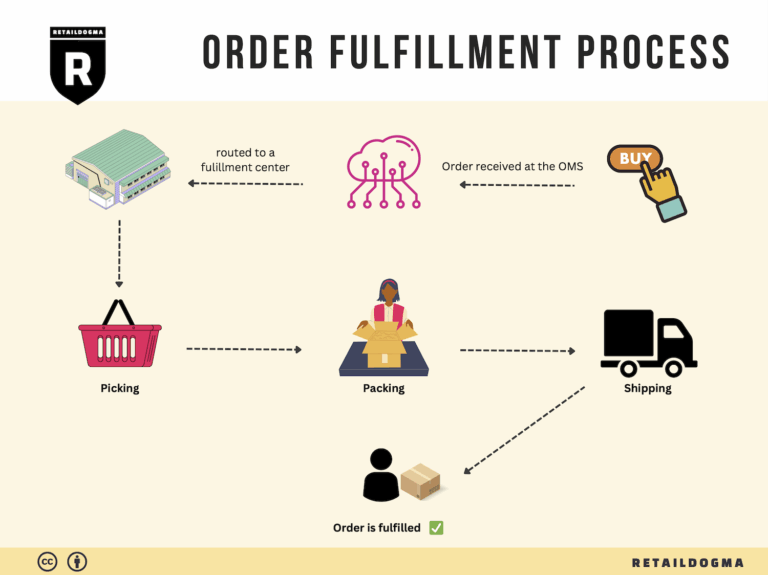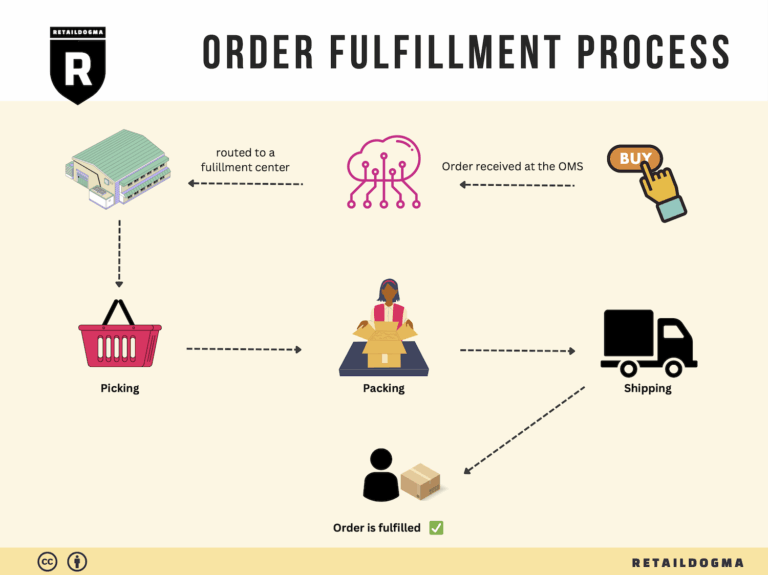How Order Fulfillment Works: A Step-by-Step Guide for Businesses
What is E-commerce Fulfillment? An Introduction for Growing Businesses
Understanding E-commerce Fulfillment: A Necessity for Growing Businesses
As an e-commerce business owner, you may find yourself grappling with the mounting challenges of packing and shipping orders. The thrill of making sales can quickly turn into a daunting task when it comes to ensuring that each product reaches your customers efficiently and on time. This overwhelming aspect of operations can divert your focus from what truly matters: growing your business and delighting your customers.
At its core, e-commerce fulfillment is the process of getting a product from your inventory to your customer’s doorstep. This encompasses various steps including inventory management, order processing, picking, packing, shipping, and handling returns. With the right fulfillment strategy, you can streamline your operations, reduce shipping costs, and enhance customer satisfaction.
In this guide, we will delve into the different fulfillment models available to you, such as Third-Party Logistics (3PL) and Fulfillment by Amazon (FBA). Understanding these options will help you identify which model aligns best with your business needs and goals.
We will also cover the core services that fulfillment partners typically offer. These include inventory distribution, order fulfillment, returns management, and even customized packaging experiences that can elevate your brand. Knowing what services are available will empower you to select a partner that can adapt to your specific requirements.
Choosing the right fulfillment partner is crucial for your business’s success. We will provide practical tips on how to assess potential partners based on their capabilities, technology, network coverage, and customer service. A well-chosen partner can significantly reduce your operational burden and enhance your customer experience.
Finally, we’ll explore pricing structures in the e-commerce fulfillment landscape. Understanding how fulfillment costs are calculated will enable you to budget effectively and make informed financial decisions that contribute to your bottom line.
The ultimate goal of this guide is to empower you with the knowledge necessary to make smart, strategic decisions about your logistics. By optimizing your fulfillment process, you can not only alleviate the stress of managing orders but also position your business for sustainable growth in a competitive market. Let’s dive in and explore the world of e-commerce fulfillment together.
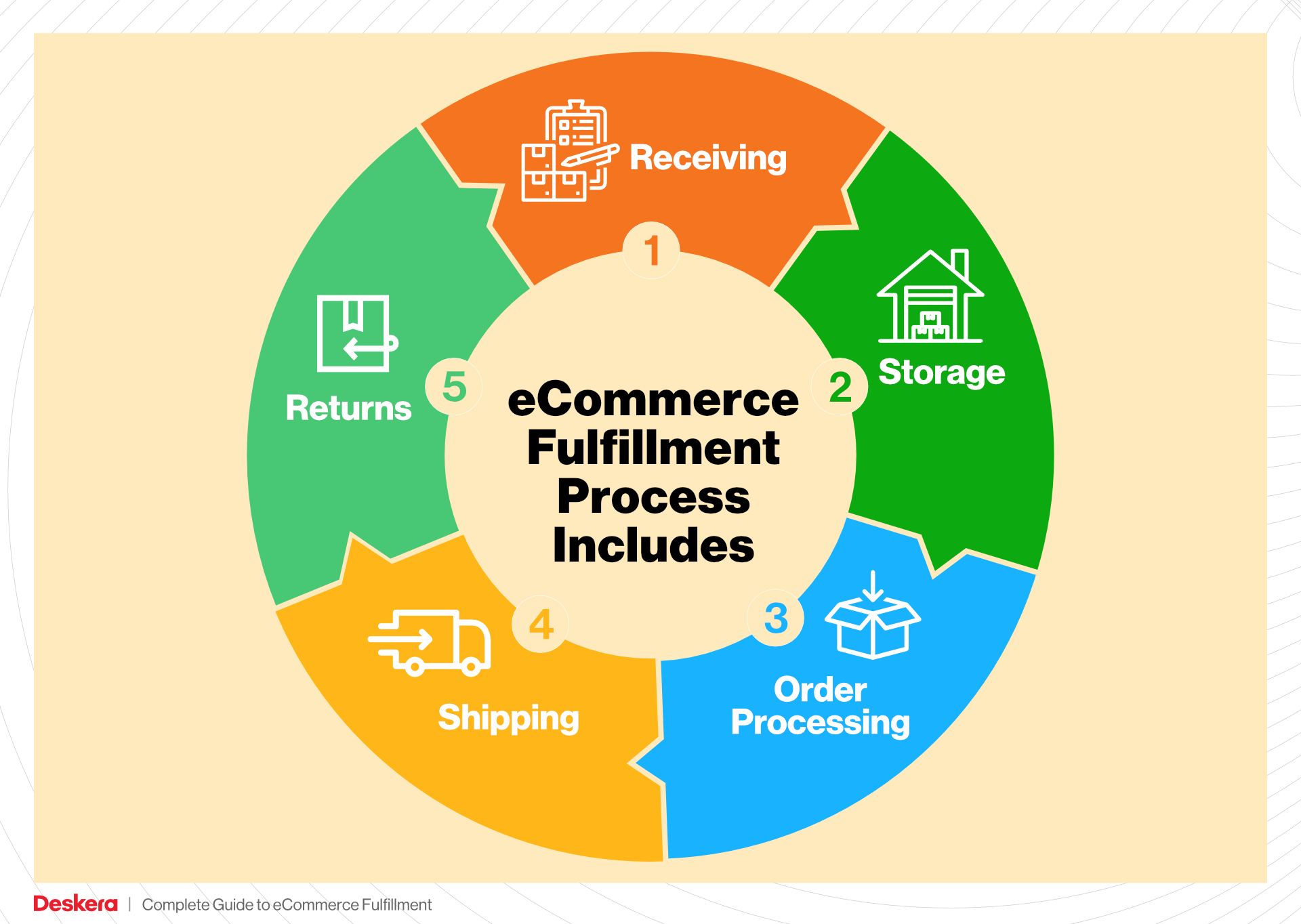
What You’ll Learn In This Guide
- What is E-commerce Fulfillment? An Introduction for Growing Businesses
- The Order Fulfillment Process: From ‘Buy’ Button to Customer’s Door
- Comparing Fulfillment Models: In-House vs. 3PL vs. Dropshipping
- A Deep Dive into Amazon FBA: Pros, Cons, and Who It’s For
- Core Services Offered by Fulfillment Centers
- How to Choose a Fulfillment Partner: A 6-Point Checklist
- Understanding Fulfillment Pricing: A Breakdown of Common Fees
- Frequently Asked Questions (FAQs) about Fulfillment
- Conclusion: Is Outsourcing Fulfillment the Right Move for Your Business?
- Important Disclaimer
The Order Fulfillment Process: From ‘Buy’ Button to Customer’s Door
1. Receiving Inventory
The order fulfillment process begins with receiving inventory from suppliers. This step is crucial as it sets the foundation for your fulfillment operation. Upon arrival, products are checked against purchase orders to ensure accuracy and quality. This involves verifying quantities, inspecting for damages, and confirming that the correct items have been delivered.
A key term associated with this step is SKU (Stock Keeping Unit). Each product should have a unique SKU that simplifies tracking and inventory management. Properly managing your inventory at this stage helps prevent stock discrepancies later in the fulfillment process. Accurate receiving also aids in maintaining good relationships with suppliers, as it ensures that any issues are addressed immediately. Inaccuracies at this stage can lead to stockouts or excess inventory, both of which can negatively impact sales and customer satisfaction.
2. Warehouse Storage
Once inventory is received and verified, the next step is warehouse storage. Efficient storage systems are vital for smooth operations and quick order fulfillment. Products are organized in a way that optimizes space and allows for easy access. This can involve using shelving units, bins, or pallets, and is often guided by principles like FIFO (First In, First Out) to ensure older stock is sold first.
A significant term here is inventory management system (IMS), which tracks where products are stored and their quantities. An effective IMS helps streamline the retrieval process and reduces the chances of errors when items are picked for orders. Proper warehouse storage not only maximizes efficiency but also minimizes the time and labor costs associated with order fulfillment. Additionally, a well-organized warehouse can enhance employee safety and reduce the risk of accidents.
3. Order Picking
Order picking is the process of retrieving items from storage to fulfill customer orders. This step is critical because the accuracy of picking directly affects customer satisfaction. Orders can be picked using various methods, including single order picking, batch picking, or wave picking, depending on the volume and nature of the orders.
Pick lists are essential tools in this phase. A pick list is a document or digital notification that outlines the items and quantities needed for each order. Using pick lists ensures that employees gather the correct products efficiently. The effectiveness of the picking process can significantly impact shipping times and overall operational costs. By optimizing picking strategies, businesses can reduce the time spent on this task, ultimately leading to faster delivery times and enhanced customer experiences.
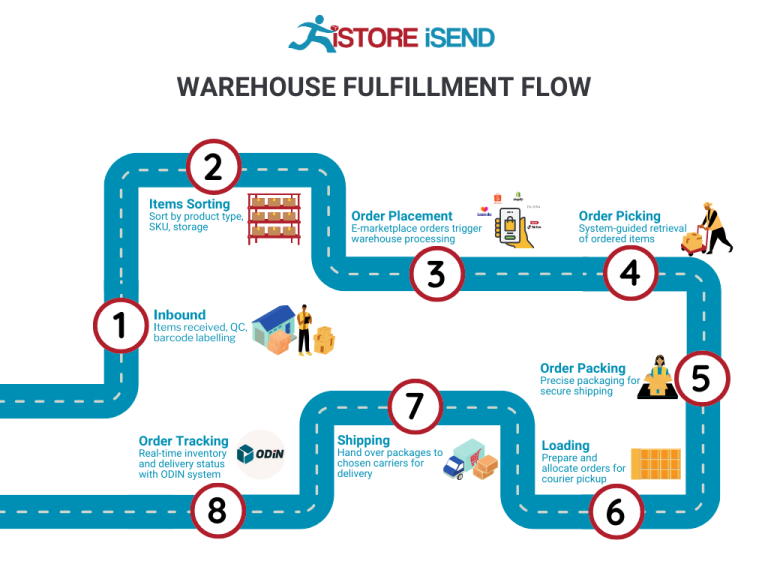
4. Order Packing
After items have been picked, they move to the packing stage. Packing is not just about placing items in boxes; it is an opportunity to ensure that products are safely secured for transit while also enhancing the customer experience. Proper packing can prevent damage during shipping and returns, which is crucial for maintaining customer satisfaction and reducing return costs.
A key term in this phase is packing slip. This document accompanies the order and typically includes details such as the items included, quantities, and return instructions. It serves as a confirmation for the customer and as a reference for handling any post-purchase issues. Thoughtful packing can also include branding elements, such as custom tape or thank-you notes, which help build a relationship with customers. An efficient packing process can reduce shipping errors and returns, contributing positively to the bottom line.
5. Shipping & Delivery
The final step in the order fulfillment process is shipping and delivery. This stage involves selecting the appropriate shipping method and carrier, printing shipping labels, and preparing packages for dispatch. Timely and accurate shipping is vital for customer satisfaction; delays can lead to frustration and loss of future business.
Shipping carriers are crucial partners in this step. Choosing the right carrier can affect delivery speed, cost, and reliability. Businesses often use shipping software to compare rates and services from various carriers, ensuring they provide the best options for customers. Additionally, providing tracking information enhances transparency and keeps customers informed about their order status. Efficient shipping and delivery not only fulfill customer expectations but also strengthen brand loyalty, as customers are more likely to return to businesses that deliver consistently and reliably.
By understanding and optimizing each step in the order fulfillment process, e-commerce businesses can enhance operational efficiency, reduce costs, and ultimately improve customer satisfaction.
Comparing Fulfillment Models: In-House vs. 3PL vs. Dropshipping
Fulfillment Model Comparison
| Model | Who Handles Inventory | Best For (Business Stage) | Key Advantage | Key Disadvantage |
|---|---|---|---|---|
| In-House Fulfillment | Business Owner/Staff | Startups & Small Businesses | Complete control over inventory and fulfillment | High overhead costs and resource allocation needed |
| Third-Party Logistics (3PL) | 3PL Provider | Growing Businesses | Scalability and cost-efficiency | Less control over inventory and fulfillment process |
| Dropshipping | Supplier | New Entrepreneurs | Low initial investment and minimal risk | Lower profit margins and dependency on suppliers |
In-House Fulfillment
In-house fulfillment involves managing the entire order processing and logistics within your own business. This model is often adopted by startups and small businesses that wish to maintain tight control over their inventory and customer experience. By handling the picking, packing, and shipping directly, businesses can ensure that products are handled according to their standards, which can be vital for brand consistency. Additionally, having your own fulfillment operation allows for greater flexibility in inventory management and the ability to offer personalized services, such as customized packaging or unique unboxing experiences.
However, the in-house model comes with significant challenges. The costs associated with warehousing, staffing, and the technology needed to manage logistics can quickly add up. For businesses with limited budgets or those that experience fluctuating sales volumes, these overhead costs can become burdensome. Moreover, as order volumes grow, maintaining efficiency can become increasingly difficult without the right infrastructure and processes in place.
Third-Party Logistics (3PL)
Third-party logistics (3PL) providers offer a comprehensive solution for businesses looking to outsource their fulfillment needs. In this model, businesses partner with a 3PL service that handles everything from inventory management to shipping logistics. This is particularly advantageous for growing businesses that may not have the resources or infrastructure to manage fulfillment efficiently on their own. 3PLs often have established networks and expertise in logistics, enabling faster shipping and potentially lower costs due to economies of scale.
One of the key advantages of using a 3PL is the ability to scale operations quickly without the heavy investment in warehousing and staffing. As order volumes increase, a 3PL can adjust resources accordingly, allowing businesses to focus on core activities such as marketing and sales. However, one of the main disadvantages is the loss of control over the fulfillment process. Businesses may face challenges in maintaining their desired level of service quality, and communication issues can arise if the 3PL does not align with the brand’s values or standards.
Dropshipping
Dropshipping is a fulfillment model where the retailer does not hold any inventory but instead transfers customer orders directly to a supplier, who then ships the products on behalf of the retailer. This model is particularly appealing to new entrepreneurs or those testing the waters in e-commerce, as it requires a low initial investment and minimal risk. Retailers can offer a wide range of products without the burden of inventory management, allowing them to focus on marketing and customer acquisition.
Despite its advantages, dropshipping has notable drawbacks. Profit margins are typically lower since the retailer has to share profits with the supplier, and there can be challenges with inventory management—especially if the supplier runs out of stock. Additionally, since the retailer does not handle the product directly, issues such as shipping delays, quality control, and customer service can become problematic. Retailers must establish strong relationships with reliable suppliers to mitigate these risks and ensure a positive customer experience.
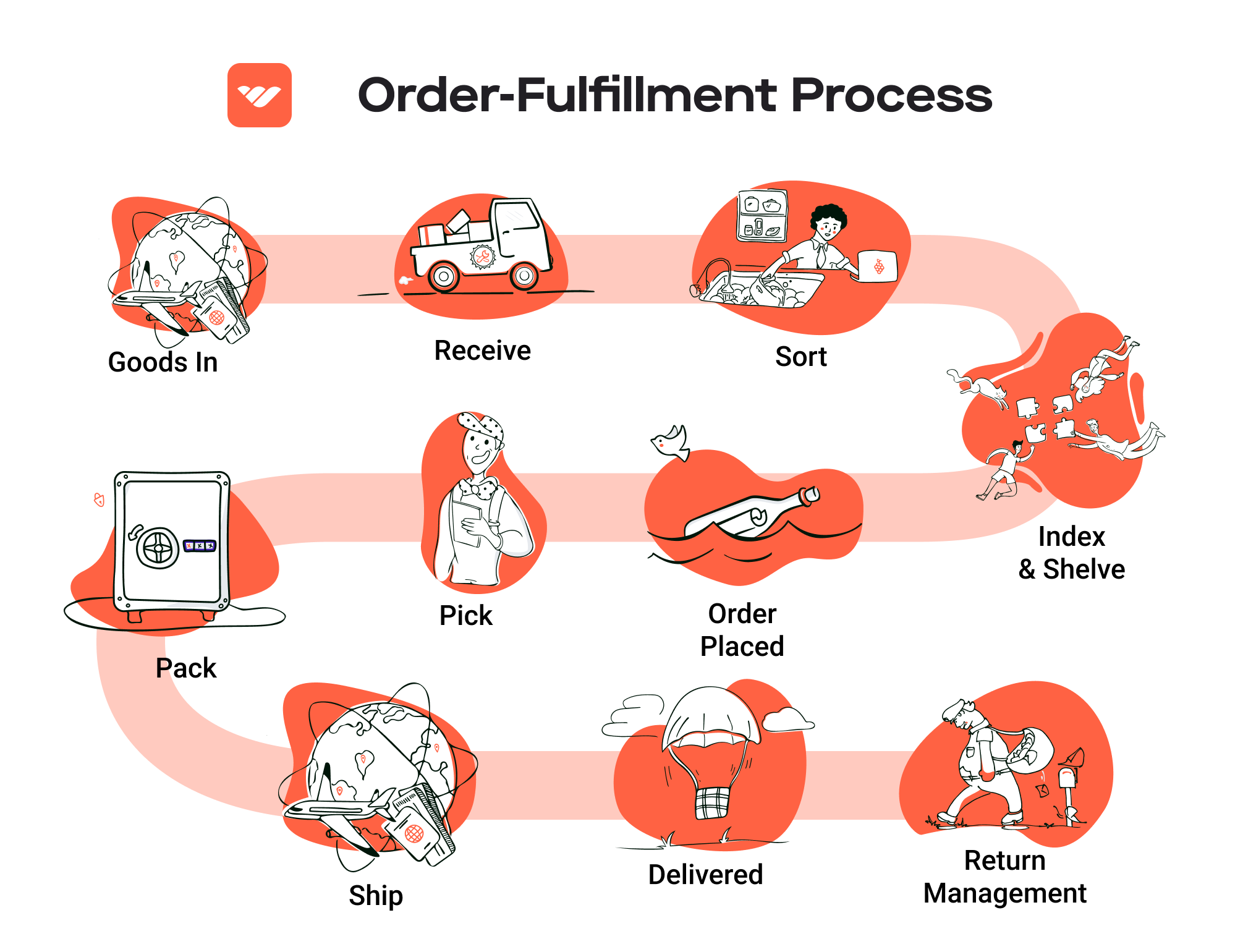
Conclusion
Choosing the right fulfillment model is crucial for e-commerce business owners, as it directly impacts customer satisfaction, operational efficiency, and overall profitability. Understanding the nuances of each model—whether it’s the control and personalization of in-house fulfillment, the scalability and cost-efficiency of 3PL, or the low-risk entry of dropshipping—can help businesses make informed decisions that align with their growth strategies and operational capabilities.
A Deep Dive into Amazon FBA: Pros, Cons, and Who It’s For
Understanding Fulfillment by Amazon (FBA)
Fulfillment by Amazon (FBA) is a service provided by Amazon that enables sellers to store their products in Amazon’s fulfillment centers. Amazon takes care of storage, packaging, and shipping of products directly to customers. This service not only streamlines the logistics for sellers but also leverages Amazon’s extensive distribution network to reach a vast customer base.
How FBA Works
-
Setup: Sellers create an Amazon seller account and enroll in the FBA program. They can then list their products for sale on Amazon.
-
Shipping Inventory: Sellers send their inventory to one or more of Amazon’s fulfillment centers. Amazon provides guidelines on how to prepare and package items for shipment.
-
Storage: Once the inventory arrives at the fulfillment center, Amazon stores it until it sells. The products are categorized and stored based on various factors, including size and type.
-
Order Processing: When a customer places an order for a product listed as FBA, Amazon handles the entire process. This includes picking the product from the shelf, packing it, and shipping it to the customer.
-
Customer Service: Amazon also manages customer service and returns for FBA products, allowing sellers to focus on other aspects of their business.
-
Tracking and Reporting: Sellers can track their inventory levels, sales, and performance metrics through the Amazon Seller Central dashboard, providing insights into their business operations.
Pros of Using FBA
1. Prime Eligibility
One of the most significant advantages of using FBA is that products become eligible for Amazon Prime, which attracts a large customer base looking for fast, free shipping. This eligibility can substantially increase sales, as Prime members tend to prefer Prime-eligible products.
2. Customer Trust
Amazon has built a reputation for reliability and customer service. By using FBA, sellers can leverage this trust, as customers are more likely to purchase from listings that feature Amazon’s fulfillment services. The “Fulfilled by Amazon” badge can enhance product visibility and credibility.
3. Multi-Channel Fulfillment
FBA isn’t limited to sales on Amazon alone. Sellers can use FBA to fulfill orders from their own websites or other sales channels. This capability allows businesses to streamline their logistics and provide consistent service across multiple platforms.
4. Scalability
FBA allows sellers to scale their businesses without the need to invest in their own warehousing and logistics infrastructure. As demand increases, sellers can easily send more inventory to Amazon without worrying about logistics.
5. Automated Customer Service
With FBA, Amazon handles all customer inquiries and returns, allowing sellers to focus on product development and marketing rather than customer service operations. This can significantly reduce operational burdens.
Cons of Using FBA
1. High Fees
FBA involves various fees, including storage fees and fulfillment fees, which can add up quickly, especially for businesses with low-margin products. Sellers need to carefully analyze their cost structure to ensure that FBA remains profitable.
2. Strict Inventory Rules
Amazon has specific requirements for inventory management, including labeling, packaging, and storage. Sellers must adhere to these guidelines or face additional fees and potential disruptions in service.
3. Commingling Risks
FBA products may be commingled with inventory from other sellers. This means that a seller’s products could potentially be shipped to customers alongside products from other sellers, which can lead to issues with quality control and brand reputation. If a buyer receives a damaged or incorrect item, it can reflect poorly on the original seller.
4. Limited Control
While FBA simplifies logistics, it also means that sellers have less control over the fulfillment process. Sellers must rely on Amazon’s systems and procedures, which can sometimes lead to errors or delays outside of their control.
5. Storage Limitations
Amazon imposes limits on how much inventory sellers can store in their fulfillment centers, particularly during peak seasons. This can restrict sellers from scaling their operations during high-demand periods.
Who is FBA Best For?
Fulfillment by Amazon is particularly beneficial for:
-
Small to Medium-Sized Businesses: Businesses that do not have the resources to manage their own warehousing and logistics can significantly benefit from the convenience of FBA.
-
E-commerce Entrepreneurs: Those who are just starting out can leverage Amazon’s infrastructure to quickly enter the market without heavy initial investments in logistics.
-
Brands with Established Products: Sellers with proven products that have consistent demand can optimize their fulfillment processes and reach more customers through Amazon.
-
Multi-Channel Retailers: Businesses that sell across various platforms can integrate FBA into their operations, ensuring they provide a consistent experience for customers regardless of where purchases are made.
In conclusion, Fulfillment by Amazon can be a powerful tool for scaling e-commerce operations. However, businesses should carefully weigh the pros and cons, ensuring that the benefits align with their operational strategies and financial goals. By understanding how FBA fits into their overall fulfillment strategy, sellers can make informed decisions that enhance their business performance.
Core Services Offered by Fulfillment Centers
Inventory Management & Warehousing
Inventory management and warehousing are the backbone of any fulfillment operation. This service involves the storage, tracking, and management of your products in a dedicated warehouse space. Fulfillment centers utilize advanced Warehouse Management Systems (WMS) that allow businesses to monitor inventory levels in real-time, set reorder alerts, and automate stock replenishment.
Benefits:
1. Enhanced Accuracy: Automated systems minimize human error in inventory counts, ensuring that you always know your stock levels.
2. Optimized Space Utilization: Fulfillment centers are designed to maximize storage capacity, allowing businesses to store varying quantities of products without the overhead of maintaining their own warehouse.
3. Scalability: As your business grows, fulfillment centers can easily accommodate increased inventory levels and diversify storage options to include seasonal products or promotional items.
4. Cost Efficiency: By leveraging shared warehouse space, businesses can significantly reduce overhead costs associated with managing their own facilities.
Pick and Pack Services
Pick and pack services refer to the process of selecting products from inventory (picking) and preparing them for shipment (packing). Fulfillment centers streamline this process using efficient workflows, barcode scanning, and trained staff to ensure quick and accurate order fulfillment.
Benefits:
1. Speedy Order Processing: Fulfillment centers can process hundreds or thousands of orders daily, ensuring that your customers receive their products quickly—often within two days.
2. Quality Control: With established protocols for picking and packing, fulfillment centers ensure that the right products are sent to the right customers, reducing returns and enhancing customer satisfaction.
3. Custom Packaging Options: Many fulfillment centers offer customizable packing solutions, allowing you to create unique unboxing experiences that reflect your brand identity.
4. Reduced Labor Costs: Outsourcing pick and pack services eliminates the need for hiring and training an in-house team, saving both time and money.
Kitting and Assembly
Kitting and assembly involve grouping individual items together to create a single product or package, often tailored for specific promotions or bundled sales. This service is particularly beneficial for businesses that offer products that are frequently sold together or require assembly before shipping.
Benefits:
1. Streamlined Operations: By outsourcing kitting and assembly, businesses can focus on core activities like marketing and sales instead of handling complex packaging tasks.
2. Increased Sales Opportunities: Bundling products can encourage customers to purchase more, increasing average order value and enhancing the overall shopping experience.
3. Customization Flexibility: Fulfillment centers can quickly adapt to changing market trends by assembling different kits or promotional packages based on customer demand.
4. Efficient Use of Resources: With skilled labor at the fulfillment center, kitting and assembly processes are often completed more efficiently than they would be in-house, allowing for quicker turnaround times.
Returns Management (Reverse Logistics)
Returns management, or reverse logistics, is the process of handling returned products. This includes everything from receiving returned items, inspecting their condition, restocking, and processing refunds or exchanges. Effective returns management is crucial for maintaining customer satisfaction and loyalty.
Benefits:
1. Customer Satisfaction: A smooth returns process enhances customer confidence in purchasing from your brand, knowing they can easily return products if necessary.
2. Cost Recovery: Efficient returns management allows businesses to quickly assess the condition of returned items and determine whether they can be restocked or need to be disposed of, thus recovering potential losses.
3. Data Insights: Analyzing return patterns can provide valuable insights into customer preferences and product quality issues, guiding future inventory and product development decisions.
4. Streamlined Operations: By outsourcing returns management, businesses can save time and resources, allowing them to focus on core operations while ensuring that returns are handled professionally.
In conclusion, partnering with a fulfillment center provides a comprehensive suite of services that can significantly enhance the efficiency and scalability of an e-commerce business. By leveraging inventory management, pick and pack services, kitting and assembly, and returns management, businesses can optimize their operations, reduce costs, and improve customer satisfaction, ultimately driving growth in a competitive marketplace.
How to Choose a Fulfillment Partner: A 6-Point Checklist
Location & Warehouse Network
Importance: The geographic location of your fulfillment partner’s warehouses is critical for optimizing shipping times and costs. A strategically located fulfillment center can help you reach your customers faster and reduce shipping expenses.
Questions to Ask:
– How many fulfillment centers do you operate, and where are they located?
– Can you provide coverage maps that show delivery times to major markets?
– Do you have the ability to distribute inventory across multiple warehouses to reduce shipping distances?
Technology & Integrations
Importance: In today’s fast-paced e-commerce environment, technology plays a pivotal role in streamlining operations. A fulfillment partner with robust technology can offer real-time tracking, inventory management, and seamless integrations with your existing e-commerce platforms.
Questions to Ask:
– What warehouse management system (WMS) do you use, and how does it integrate with popular e-commerce platforms?
– Can you provide real-time inventory updates, and how do you handle stockouts or low inventory alerts?
– What automation features do you offer to enhance order processing efficiency?
Specializations (e.g., Cold Storage, Oversized Items)
Importance: Not all fulfillment partners are equipped to handle every type of product. If your business involves specialized items such as perishables, oversized products, or hazardous materials, it’s essential to partner with a provider that has the necessary capabilities and certifications.
Questions to Ask:
– Do you have experience handling my specific product type? What special facilities or equipment do you have?
– Are your warehouses temperature-controlled, and do you have the capacity for cold storage if needed?
– What certifications do you hold for handling specialized items, and can you provide references?
Scalability & Capacity
Importance: As your business grows, so will your fulfillment needs. It’s vital to choose a partner who can scale alongside you, whether it’s accommodating seasonal spikes in order volume or expanding your product range.
Questions to Ask:
– How do you handle fluctuations in order volume during peak seasons?
– Can you provide examples of how you’ve scaled with other clients?
– What is your maximum order capacity, and how quickly can you onboard additional resources if needed?
Pricing and Contracts
Importance: Understanding the pricing structure and contract terms of your fulfillment partner is essential to avoid unexpected costs that could impact your bottom line. Transparent pricing helps you budget effectively and maintain profitability.
Questions to Ask:
– Can you provide a detailed breakdown of your pricing model (e.g., storage fees, picking and packing fees, shipping costs)?
– Are there any hidden fees I should be aware of, such as setup fees or charges for returns?
– What is the length of your contract, and what are the terms for exiting or renegotiating?
Customer Support & Reviews
Importance: Exceptional customer support is crucial when issues arise, whether they are related to order fulfillment, inventory management, or technology. A reliable partner should have a solid track record of customer service.
Questions to Ask:
– What support channels do you offer (e.g., phone, email, chat), and what are your response times?
– Can you provide references or case studies from current or past clients?
– How do you handle complaints or issues, and what is your escalation process?
Conclusion
Choosing the right fulfillment partner is a pivotal decision that can significantly impact your e-commerce operations. By evaluating potential partners against this checklist, you can ensure that you select a provider that aligns with your business needs, supports your growth ambitions, and enhances your overall customer experience. Take the time to ask the right questions and gather insights that will help you make an informed choice.
Understanding Fulfillment Pricing: A Breakdown of Common Fees
Initial Setup Fees
When partnering with a fulfillment center, initial setup fees are often the first costs that e-commerce businesses encounter. These fees typically cover the onboarding process, which may include account setup, software integration, and training. The cost can vary significantly based on the provider, ranging from a few hundred to several thousand dollars.
To calculate initial setup fees, providers may consider factors such as the complexity of your operations, the number of SKUs (stock-keeping units) you plan to manage, and the level of customization required for your integration. Some fulfillment centers may offer promotional discounts or waive these fees altogether, particularly for businesses committing to long-term contracts or high volumes.
Receiving Fees
Receiving fees are charged when your inventory arrives at the fulfillment center. These fees cover the labor and resources required to unload, inspect, and store your products. Typically calculated on a per-pallet or per-box basis, receiving fees can vary based on the size and weight of the shipment, as well as the number of SKUs being received.
To minimize receiving fees, consider consolidating shipments or working with a fulfillment partner that offers lower rates for bulk arrivals. Additionally, efficient labeling and organization of your products can streamline the receiving process, potentially reducing labor costs associated with handling.
Storage Fees (per pallet/bin)
Storage fees are recurring charges that e-commerce businesses incur for keeping their inventory in the fulfillment center’s warehouse. These fees are generally calculated on a per-pallet or per-bin basis and can be charged monthly or quarterly. The cost may vary depending on the size of the items and the total volume of inventory stored.
To optimize storage costs, consider employing strategies such as inventory forecasting to avoid overstocking and maintain lean inventory levels. Some fulfillment centers offer tiered pricing, where the cost per pallet decreases as you store more inventory, which can be beneficial for scaling businesses.
Pick & Pack Fees (per item/order)
Pick and pack fees are charged for the labor involved in retrieving items from storage and preparing them for shipment. This fee can be structured in various ways: per item, per order, or a combination of both. For instance, a fulfillment center might charge a flat fee for picking an order, plus an additional fee for each item included in that order.
To reduce pick and pack fees, consider optimizing your product offerings and order fulfillment processes. Implementing a minimum order quantity or bundling products can help streamline picking processes, potentially leading to lower costs. Additionally, choosing a fulfillment partner with efficient technology and automation can enhance speed and accuracy, further driving down these fees.
Shipping Fees
Shipping fees are perhaps the most variable and significant cost associated with fulfillment. These fees cover the transportation of products from the fulfillment center to the customer and are influenced by several factors, including package weight, dimensions, shipping method, and destination. Fulfillment centers often negotiate discounted rates with carriers based on their shipping volume, allowing them to offer competitive pricing to clients.
To effectively manage shipping costs, businesses should evaluate different shipping options, such as standard vs. expedited services, and consider the implications of offering free shipping. Additionally, working with a fulfillment partner that provides transparent pricing models and a variety of shipping options can help you choose the most cost-effective solution for your business.
Tips for Getting an Accurate Quote
-
Provide Detailed Information: When requesting a quote, be prepared to share comprehensive details about your business, including order volumes, product dimensions, and expected growth rates. This information helps fulfillment providers tailor their quotes to your specific needs.
-
Ask About Hidden Fees: Inquire about any potential hidden fees, such as charges for returns, inventory audits, or additional services. Understanding the full cost structure will give you a clearer picture of your total fulfillment expenses.
-
Compare Multiple Providers: Don’t settle for the first quote you receive. Compare offerings from several fulfillment centers to assess the best value for your needs. Look beyond pricing to consider service levels, technology, and scalability.
-
Negotiate Terms: Many fulfillment centers are open to negotiation, especially if you’re committing to a long-term partnership. Explore options for reducing fees based on volume or length of contract.
-
Request a Trial Period: If possible, negotiate a trial period to assess the fulfillment center’s performance before committing to a long-term agreement. This allows you to evaluate their service quality and ensure they meet your operational requirements.
By understanding these common fulfillment pricing models and employing strategic approaches to manage costs, e-commerce businesses can effectively scale their operations while maintaining quality service for their customers.
Frequently Asked Questions (FAQs) about Fulfillment
1. What is an eCommerce fulfillment center?
An eCommerce fulfillment center is a specialized warehouse that stores inventory and handles the entire order fulfillment process for online retailers. This includes receiving inventory, picking and packing orders, shipping them to customers, and managing returns. By outsourcing these tasks to a fulfillment center, businesses can streamline operations, reduce shipping times, and improve customer satisfaction.
2. How does an eCommerce fulfillment center work?
When you partner with a fulfillment center, you send your inventory to their warehouse. Once an order is placed on your online store, the fulfillment center receives the order details, picks the items from the shelves, packs them securely, and ships them directly to the customer. Most fulfillment centers also offer tracking, inventory management, and reporting tools to help you monitor your operations.
3. What’s the difference between a warehouse and a fulfillment center?
While both warehouses and fulfillment centers store goods, their purposes differ significantly. A warehouse primarily focuses on storage and inventory management, often catering to bulk orders and long-term storage. In contrast, a fulfillment center is designed for quick turnaround and order processing, emphasizing efficient picking, packing, and shipping to meet customer demand promptly.
4. What is a 3PL?
A 3PL, or third-party logistics provider, is a company that offers outsourced logistics services, including warehousing, fulfillment, and distribution. By partnering with a 3PL, eCommerce businesses can leverage their expertise, technology, and network to enhance supply chain efficiency without the need to manage these processes in-house.
5. How much do fulfillment services cost?
Fulfillment service costs can vary widely based on several factors, including order volume, storage space required, packaging needs, and shipping methods. Typically, costs are broken down into fees for storage, order processing, shipping, and additional services (like returns management). It’s crucial to request quotes from multiple fulfillment centers to compare pricing structures and find the best fit for your budget and needs.
6. How can I choose the right fulfillment center for my business?
Selecting the right fulfillment center involves evaluating several key factors, including:
- Location: Proximity to your customer base can reduce shipping times and costs.
- Services Offered: Ensure they provide all necessary services, such as inventory management and returns processing.
- Technology Integration: Look for centers that integrate seamlessly with your eCommerce platform and provide real-time tracking and reporting.
- Reputation and Reliability: Research reviews and case studies from other businesses to gauge their reliability and service quality.
7. Can fulfillment centers handle international shipping?
Yes, many fulfillment centers offer international shipping services. They can manage customs clearance, duties, and tariffs to ensure your products reach global customers efficiently. When choosing a fulfillment partner, inquire about their capabilities in international logistics to ensure they can meet your business’s needs.
8. What are the benefits of using a fulfillment center?
Utilizing a fulfillment center can provide several advantages:
- Cost Savings: Reduce overhead costs associated with warehousing, labor, and shipping.
- Scalability: Easily scale operations up or down based on demand without the burden of managing logistics in-house.
- Improved Shipping Times: Access to multiple warehouses can enable faster shipping options, enhancing customer satisfaction.
- Focus on Core Business: Free up time and resources to concentrate on marketing, product development, and customer engagement.
9. What should I look for in a fulfillment center contract?
When reviewing a fulfillment center contract, consider the following:
- Fee Structure: Understand all associated costs, including hidden fees for storage, order processing, and shipping.
- Service Level Agreements (SLAs): Look for clear commitments on order accuracy, shipping times, and inventory management.
- Flexibility: Ensure the contract allows for adjustments in volume and services as your business grows.
- Termination Clauses: Know the terms for ending the partnership if it doesn’t meet your expectations.
10. How do I optimize my inventory for fulfillment?
To optimize your inventory for fulfillment, consider these strategies:
- Forecast Demand: Analyze sales data to predict future demand and adjust inventory levels accordingly.
- Diversify Inventory Locations: Use multiple fulfillment centers to reduce shipping times and costs.
- Implement Inventory Management Tools: Leverage technology to track inventory levels, manage reorders, and prevent stockouts or overstock situations.
- Regularly Review Performance Metrics: Monitor key metrics, such as order accuracy and shipping times, to identify areas for improvement.
Conclusion: Is Outsourcing Fulfillment the Right Move for Your Business?
Evaluating the Benefits of Outsourcing Fulfillment
Outsourcing your fulfillment process can be a game changer for your e-commerce business. By partnering with a reputable fulfillment service, you can save significant time and resources. This allows you to focus on core business activities such as marketing and product development, rather than getting bogged down in logistics. Fulfillment centers specialize in inventory management, order processing, and shipping, ensuring that you benefit from their expertise and technology without having to invest heavily in infrastructure or staff.
Scalability is another compelling advantage of using a fulfillment service. As your business grows, so do your order volumes and logistical complexities. A fulfillment partner can provide the necessary resources to handle increased demand efficiently, often across multiple locations. This means you can offer competitive shipping options, such as two-day delivery, without the headaches of managing a larger warehouse operation. The ability to adapt quickly to market changes or seasonal spikes can be a significant asset in today’s fast-paced e-commerce environment.
However, the key to reaping these benefits lies in choosing the right fulfillment partner. Not all providers offer the same level of service, technology, or pricing. It’s crucial to conduct thorough research and audits of potential partners, ensuring their capabilities align with your business needs and growth objectives.
Take Action
To determine if outsourcing fulfillment is the right next step for your business, conduct an audit of your current shipping and fulfillment processes. Evaluate your shipping costs, delivery times, and customer satisfaction levels. This exercise will help clarify whether a fulfillment partner can provide the efficiency and scalability you need to elevate your e-commerce operation. Consider reaching out to potential partners for consultations and quotes to better understand how they can contribute to your growth strategy.
Important Disclaimer
⚠️ Important Disclaimer
The information in this guide is for educational purposes. Fulfillment services, pricing, and platform features change frequently. Always conduct your own due diligence and consult with providers directly before making business decisions.
